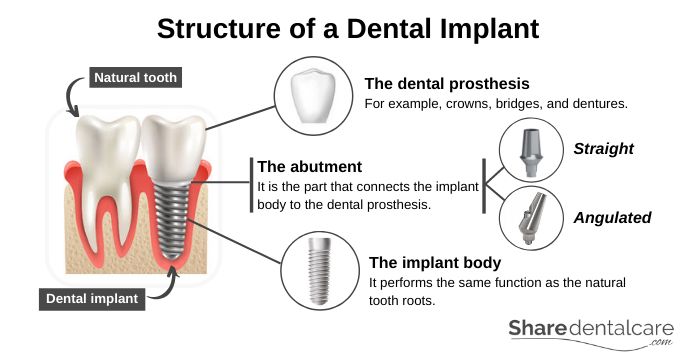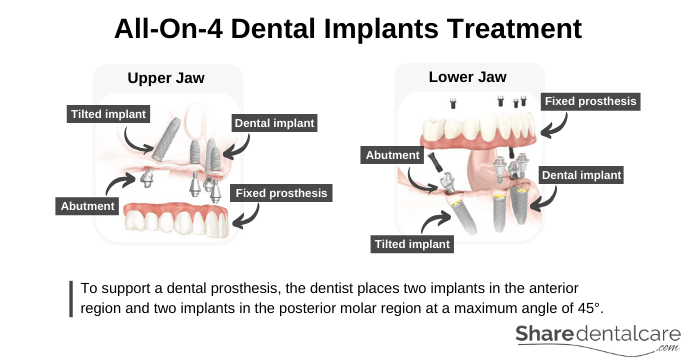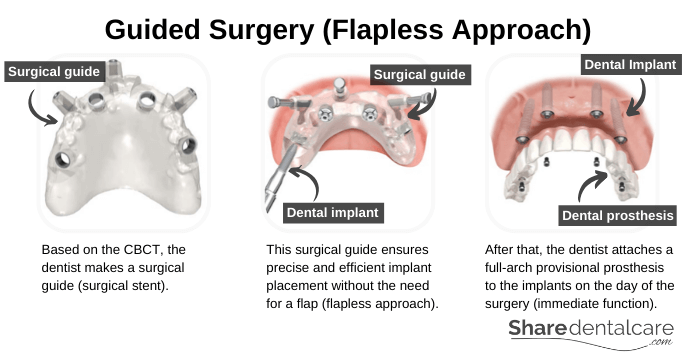All-on-4 dental implants is a surgical procedure that involves the rehabilitation of a completely edentulous jaw with only four implants, and attaching a fixed full-arch prosthesis to these implants on the day of surgery. Edentulism is the condition of being toothless (complete or partial), which has a major impact on general and psychological health. Teeth make us look good when we smile or talk. They help us cut, grind, and chew the food. Also, teeth play a major role in the pronunciation of various sounds (s, z, j, x, d, n, l, t, f, v, & th). Edentulism lowers the patients’ quality of life and makes them embarrassed when they smile, talk, or eat, leading to decreased self-esteem.
Dental implants provide a solution for patients with a completely edentulous jaw. The dentist places eight implants in the upper jaw and six implants in the lower jaw to support a fixed full-arch prosthesis. However, this solution is expensive and not suitable for patients with moderate to severe bone loss. So, a new solution is needed. At the end of the 1990s, Portuguese dentist Paulo Maló and the implant manufacturer Nobel Biocare developed the All-on-4 dental implants concept, which is a fast, cost-effective alternative to conventional implant techniques. In this article, we will discuss:
- What is a dental implant?
- Conventional implant technique vs. All-on-4 treatment concept.
- All-on-4 procedure step by step.
- What to expect after the procedure?
- Post-operative instructions.
What is a Dental Implant?
To fully understand the All-on-4 technique, you should first know what a dental implant is. The implant is an artificial tooth root that is surgically placed into the jawbone below the gum line to replace a missing tooth or teeth. The jawbone fuses with the implant (osseointegration), providing stable support for a dental prosthesis, such as a crown, bridge, or denture. A conventional dental implant consists of:
- The implant body: It looks like titanium screws and can be made of titanium or zirconia. The implant-body function is to provide support for a dental prosthesis. The dentist places the implant body into the jawbone. After that, the bone grows and fuses with implant-body (osseointegration), which can take from 4 to 6 months.
- The abutment: It connects the implant body to the dental prosthesis. There are straight and angulated abutments.
- The dental prosthesis: the implant-supported prosthesis can be categorized into:
- A fixed prosthesis, such as a crown and dental bridge.
- A removable prosthesis, such as dentures.

What are the All-On-4 Dental Implants?
The All-on-4 dental implants treatment is a surgical, prosthodontic procedure that involves the rehabilitation of an edentulous jaw by placing four implants only. These four implants support a full-arch prosthesis, which contains 10 to 14 artificial teeth.
The All-on-4 technique is suitable for patients with an edentulous jaw or jaw with remnant hopeless teeth. Also, All-on-4 dental implants treatment is best for patients who have jawbone loss that prevents them from getting dental implants by using conventional techniques.
Conventional Dental Implant Technique
Conventionally, to support a fixed full-arch prosthesis in an edentulous jaw, you will need at least eight implants in the upper jaw and six implants in the lower jaw. Also, you may need a bone graft if the jawbone is thin, soft, or insufficient to create a more solid base for the implants.
After the placement of the implants, you won’t receive any prosthesis until the osseointegration is complete (delayed loading of the implants). Because attaching the prosthesis to the implants during the healing stage (osseointegration) can cause implant movement and failure. Osseointegration is the fusion between the jawbone and the implant, which can take three to six months.
Sometimes, the dental implant is contraindicated because the jawbone is insufficient or/and the anatomical structures, such as maxillary sinuses or nerves are too close.
All-On-4 Dental Implants Concept
In the all-on-4 treatment concept, you will need four implants only to support a fixed full-arch prosthesis. Your dentist will insert two implants in the anterior region (the place of lateral incisors) and two implants in the posterior molar region at a maximum angle of 45°. The All-on-4 dental implant treatment takes advantage of the dense bone in the anterior region. Besides, placing the posterior implants at an angle makes the implant secure and stable, which usually eliminates the need for bone grafting (graft-less procedure).
Often, you will receive a temporary fixed prosthesis on the day of the surgery (immediate loading of the implants), which you will wear during the healing period (osseointegration).
The All-on-4® treatment concept is usually best for patients with close anatomical structures, such as maxillary sinuses and nerves because tilting the posterior implants helps avoid the anatomical structures.
The All-on-4 technique allows for the immediate placement of dental implants and attachment of a temporary full-arch prosthesis on the same day of surgery.

Advantages of All-On-4 Procedure
- Fewer implants, less cost (cost-effective solution).
- Suitable for patients with a thin or narrow jawbone. No need for a bone graft (graft-less procedure).
- Suitable for patients with close anatomical structures such as maxillary sinuses and nerves.
- You can receive a temporary fixed prosthesis on the day of the surgery (immediate loading of the implants).
- It supports a fixed prosthesis, which is:
- Better in aesthetics and chewing function than removable dentures.
- More comfortable than traditional dentures.
Disadvantages of All-On-4 Procedure
- Higher load on the inclined implants.
- Possible problems due to the immediate loading of the implants.
- The temporary prosthesis will increase the total cost of the procedure.
Is the All-On-4 Dental Implants Suitable for All Patients?
Generally, All-on-4 implants treatment is suitable for patients with a completely edentulous jaw, especially if they
- Have a thin or narrow jawbone.
- Have close anatomical structures such as maxillary sinuses and nerves.
- Are looking for a cost-effective alternative to conventional implant techniques.
- Want a temporary prosthesis on the day of the implant surgery (immediate function).
- Want a permanent fixed prosthesis.
You can talk to your dentist to see if the All-on-4 technique is the right option for you.
Contraindications
Usually, dental implants are suitable for patients with a missing tooth/teeth. However, they are contraindicated in the following cases:
- During pregnancy.
- Patients younger than 18 years old.
- Heavy smokers.
- Alcoholism and drug abuse.
- Patients receiving radiotherapy or chemotherapy.
- Health conditions or diseases that affect the healing process:
- Metabolic diseases, such as uncontrolled diabetes mellitus.
- Bleeding disorders.
- Immune suppressive disorders.
- Bone disorders, such as Paget’s disease.
You need to visit your dentist to see if the dental implants are suitable for you because every patient needs to be evaluated on an individual basis.
All-On-4 Dental Implants Procedure (Step-by-Step)
Pre-Operative Planning
The pre-operative planning is necessary for the success of the All-on-4 dental implant procedure. So, your dentist will:
- Review your medical history: Some medical conditions such as diabetes mellitus and bone disorders can affect the healing process, causing implant failure. So, tell your dentist about previous and existing medical conditions and any medications you take to prevent complications.
- Examine your mouth: Your dentist will examine your mouth with a mirror and probe, and take a dental impression to make a study model. Also, your dentist will ask for a 3D x-ray (cone beam computed tomography CBCT). The CBCT provides accurate information about:
- The bone density (bone quality assessment).
- The location of anatomical structures, such as maxillary sinuses and nerves.
- Make a treatment plan: The dentist will use your study model and CBCT to make a treatment plan, which includes:
- The extraction of remaining and broken teeth.
- Planning the exact position and angulation of the implants.
- Making a surgical guide for precise implant insertion.
- The prefabrication of a temporary prosthesis for attaching it immediately after the surgery (immediate function).
- Determining the type of final prosthesis.
Anesthesia
The all-on-4 dental implants procedure is an oral surgery. So, you will need anesthesia to feel comfortable during the procedure. The anesthesia options include:
- Local anesthesia: often, the dentist uses local anesthesia for the placement of the implants. Local anesthesia won’t interfere with your state of alertness, and you will be awake during the procedure.
- Conscious sedation: your dentist may offer local anesthesia in combination with conscious sedation to help you reduce anxiety and discomfort during the procedure. It will produce a dream-like state and make you feel relaxed. Conscious sedation is beneficial for patients with extreme dental anxiety. You may receive the medication used in conscious sedation through:
- Oral tablets.
- Intramuscular injection (IM).
- An intravenous line (IV).
- Inhalation (nitrous oxide).
- General Anesthesia: under general anesthesia, you will be completely unconscious and won’t remember or feel anything that is occurring during the all-on-4 procedure.
Visit your dentist to discuss which anesthesia option is suitable for you.
The Placement Surgery
The dentist or oral surgeon performs the All-on-4 implants treatment in two ways:
- Conventional surgery (with flap).
- Flapless surgery (flapless approach).
Conventional Surgery (with Flap)
First, your oral surgeon will use a scalpel to make an incision in the gum (flap) and expose the jawbone underneath. Then, they will place the four implants in the jawbone using the All-on-4 guide.
The oral surgeon will place two implants in the posterior region at a maximum angle of 45°, and two implants in the anterior region (in the place of lateral incisors).
After that, the oral surgeon will suture back the flap and connect the abutments to the implants. After suturing, the dentist will attach a temporary fixed prosthesis to the implants (immediate loading of the implants).
You will receive the final prosthesis after a sufficient healing period. Sometimes, your dentist may recommend a conventional healing period before receiving a temporary or final prosthesis (delayed loading of the implants).

Guided Surgery (Flapless Approach)
The dentist or oral surgeon will use your cone-beam computed tomography (CBCT) for:
- Bone quality assessment
- Plan the exact position and angulation of the implants virtually for optimal insertion.
Then, the oral surgeon will send this planned CBCT to the dental laboratory for the fabrication of a custom-designed surgical guide.
This surgical guide ensures precise and efficient implant insertion without the need for a flap (flapless approach). After the placement of the implants with the surgical guide, the dentist will attach the abutments and a temporary prosthesis to the implants on the day of the surgery (immediate loading of the implants). Sometimes, your dentist may recommend a conventional healing time before attaching a temporary or final prosthesis to the implants (delayed loading).
The guided implant placement surgery is a minimally invasive technique, which minimizes the risk of pain and swelling and ensures accurate, safe, optimal insertion. However, it will increase the total cost of the procedure.

Healing Time
After the placement of the implants in the jawbone, the bone begins to grow and fuse with the implants (osseointegration). This process can take from three to six months, depending on the quality of the bone.
Usually, you will receive a temporary fixed prosthesis on the day of the surgery (immediate loading) to wear during the healing period.
After the osseointegration is complete, you will receive the final prosthesis. Sometimes, the dentist or surgeon recommends a delayed loading protocol, which means that you won’t receive a temporary or final prosthesis until osseointegration is complete.
The Dental Prosthesis
The Temporary Prosthesis
On the day of the surgery, you may receive a temporary all-acrylic bridge, to wear during the healing period. Sometimes, the dentist converts an existing removable denture into a temporary prosthesis.
All-acrylic prostheses are not suitable for long-term use as they may not be as durable as permanent restorations. However, they provide aesthetic and functional benefits while your jawbone heals and integrates with the implants. Your dentist will provide instructions on how to care for and maintain your temporary prosthesis.
The Final prosthesis
The All-on-4 final prosthesis is highly esthetic and available in different material options:
- Acrylic teeth and gingiva over a titanium framework.
- Composite veneered over a titanium framework.
- Porcelain crowns are cemented on a metal framework.
Both acrylic and composite look similar to natural teeth and are economical options. Porcelain is a more expensive, popular, and superior option. Porcelain looks identical to natural teeth and is more durable than composite and acrylic prostheses.
What to Expect After the All-On-4 Dental Implants Surgery?
You may experience discomfort after the All-on-4 dental implants surgery, like any surgical procedure. So, your dentist will prescribe painkillers to help you control the pain after surgery. Also, you may experience:
- Swelling of your gums and face.
- Bruising of your gums or face.
- Minor bleeding and pain at the site of the surgery.
- Limited mouth opening.
These signs and symptoms are normal after the surgery, and you can control them by using pain medications and anti-inflammatory medications. However, if these signs and symptoms get worse, you should visit your dentist or surgeon immediately.
Instructions After the All-On-4 Dental Implants Procedure
Before the surgery, ask your dentist or oral surgeon about the steps of the procedure, the type of anesthesia suitable for you, and postoperative instructions. These instructions are similar to tooth extraction aftercare instructions.
On the Day of the Surgery
In the first 24 hours, all-on-4 patients should:
- Take the prescribed painkillers and anti-inflammatory medications to control the pain.
- Maintain good oral hygiene by using a soft-bristled toothbrush.
- Avoid things that may disturb the blood clot and promote bleeding:
- Avoid hot foods and drinks.
- Don’t spit or rinse your mouth.
- Avoid aspirin because it inhibits blood clotting.
- Don’t touch the surgical site with your finger or tongue.
- Avoid lifting heavy objects and exercise.
- Apply cold compresses (ice packs) to your face. This will help reduce the swelling. Note: put a towel between the ice pack and your face to avoid ice burn.
- Avoid smoking because it affects the healing process and increases the risk of implant failure.
- Proper nutrition is important for the healing process. So, you should:
- Eat soft, cool foods such as mashed potatoes, eggs, and a milkshake.
- Avoid foods such as chips, popcorn, and nuts.
- Avoid alcohol drinking.
- Ask a family member or a friend to take you home after the surgery because you may not be able to drive.
Instructions After the First 24 Hours
- Rinse your mouth with warm salt water (half a teaspoon of salt to a cup of warm water).
- Or you can use a chlorhexidine mouthwash twice daily.
- Limit physical activities in the first 48 hours after the surgery, and avoid exercise and lifting heavy objects to prevent postoperative bleeding.
- Don’t smoke because smoking affects the healing process and can cause implant failure.
- You can return to your normal diet after 48 hours.
- Contact your dentist if you have questions or problems.
Following these instructions will help you speed up the healing process and prevent complications.
Complications of the All-On-4 Dental Implants Procedure
The All-on-4 dental implants treatment has over 95% success rate. However, complications may occur like any surgical procedure.
Complications During the Surgery
There are always risks involved with any surgical procedure. The risks include:
- Infection at the surgical site.
- Injury to the nerve: This can lead to numbness or tingling of the lip, tongue, and chin.
- Injury to blood vessels: This can lead to excessive bleeding.
- Perforation of the maxillary sinus: It can lead to a sinus infection.
- Poor primary implant stability: It can lead to implant failure.
Complications During the Healing Period
Sometimes, the implant fails to integrate with the jawbone (failure of osseointegration), leading to implant mobility and failure. The failure of osseointegration may occur in the first 6 months due to several factors such as poor oral hygiene, smoking, uncontrolled diabetes, and poor primary stability during the surgery.
Long-Term Complications
In some cases, a destructive inflammatory process may affect the bone surrounding the implants, causing bone loss. This condition is known as peri-implantitis, which may occur due to poor oral hygiene, smoking, bruxism, gum disease (periodontal disease), and uncontrolled diabetes.
Conclusion
Do you have an edentulous jaw? Are you looking for a cost-effective alternative to the conventional implant technique? The all-on-4® treatment concept could be a suitable option for you.
Conventionally, the oral surgeon places eight implants in the upper jaw and six implants in the lower jaw to support a full-arch bridge. While in the All-on-4, the oral surgeon places four implants only per jaw to support a full-arch bridge. Fewer implants mean less cost.
Besides, the All-on-4 is suitable for edentulous patients with minimum jawbone volume because the dentist places the posterior implants at an angle, which makes them secure and stable. Visit your dentist to know if the All-on-4 is suitable for you.